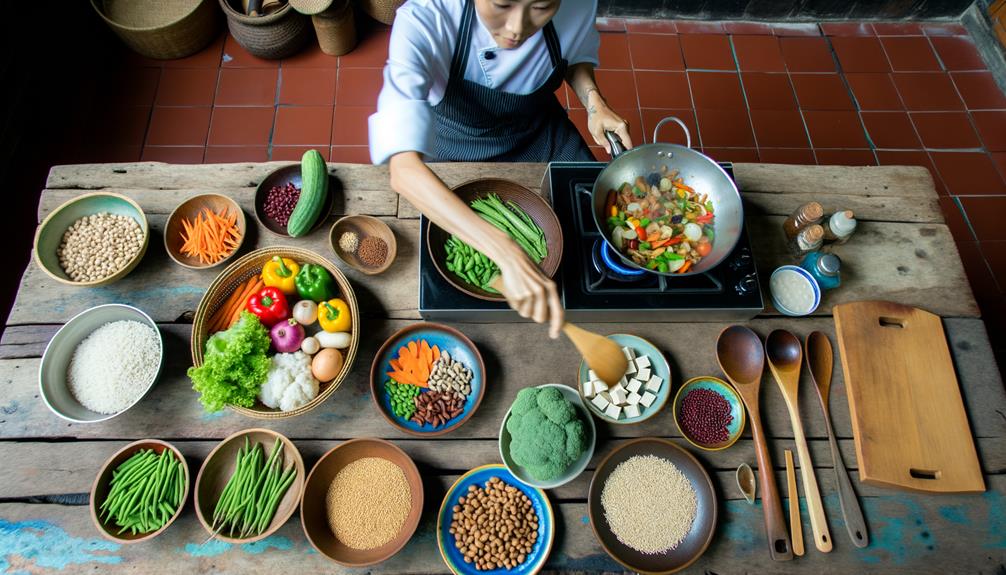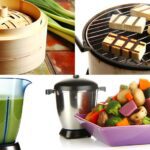Just like a painter needs a good set of brushes, you need the right techniques to create a masterpiece in your kitchen. Don't worry, though, we're not talking about anything overly complicated. The seven best methods for crafting mouthwatering vegan dishes are surprisingly simple, yet they can make a world of difference in your cooking. We'll explore everything from mastering oil-free sautéing to creating the creamiest vegan ice cream, also known as nice cream. By the end, you'll be ready to turn any selection of plant-based ingredients into a vibrant, flavorful dish. Ready to discover the secrets that will elevate your vegan cooking game?
Key Takeaways
- Oil-free cooking techniques can enhance flavors and reduce calorie-dense oils, allowing the true flavors of ingredients to shine through.
- Developing essential knife skills can improve meal prepping efficiency and precision in cutting ingredients.
- Cooking whole grains perfectly adds nutrients and satisfying texture to vegan dishes, and pressure cookers can be used for perfect brown rice.
- Excelling in vegan stir-fry techniques involves chopping vegetables uniformly, using soy sauce for umami flavor, and experimenting with different vegetable combinations and seasonings.
Mastering Oil-Free Sautéing, Baking, and Roasting
Dive right into mastering oil-free sautéing, baking, and roasting, techniques that not only enhance flavors but also cut back on calorie-dense and nutrient-stripped oils in your diet. It's a great way to breath new life into your easy vegan recipes. You may have a love affair with olive oil, but there's a whole world of flavor you're yet to explore.
As you venture into vegan cooking, tips like these are invaluable. By cooking without oil, you're not just cutting out fats, you're also allowing the true flavors of your ingredients to shine through. Your food will be healthier, more delicious, and still have that satisfying texture you crave.
When you're sautéing, aim for a 'dry sauté'. Use a bit of water or vegetable broth instead of oil to prevent your food from sticking to the pan. Remember, it's all about mastering oil-free sautéing.
As a beginner in vegan cooking, don't be afraid to experiment. Play with spices, try different cooking techniques, and always strive to learn more. Your journey into vegan cooking is just beginning, and with these tips, you're set to make it a delicious adventure. So, ready your kitchen and start cooking, the vegan way!
Developing Essential Knife Skills
Next up in your vegan cooking journey, it's time to finesse your knife skills, truly a game-changer when it comes to prepping ingredients swiftly and safely. Mastering basic knife techniques can transform not only the way you cook but also the enjoyment of the process. So, let's get chopping!
- Properly holding a knife will help you slice through your vegan food with ease and precision. It's crucial to get a good grip on the handle, using your fingers to guide the blade.
- Learn the art of dicing an onion, an essential technique that applies to many other ingredients in your vegan recipes.
- Your KITCHEN SKILLS will significantly improve by mastering different cutting techniques. Slicing, dicing, and julienning will be a breeze.
- Use a visual guide to help you understand the different cuts better, helping you perfect your meal prepping skills.
- Discover the three knives that are key to your cooking activities – a chef's knife, a paring knife, and a bread knife. They'll be your best friends when cooking beans, chopping veggies, or slicing tofu.
Cooking Whole Grains Perfectly
Having honed your knife skills, you're now ready to tackle the art of cooking whole grains to perfection, a core element in many tantalizing vegan dishes. Understanding the variety of whole grains, their cooking times, and the right methods for each is essential to your cooking skills.
Whole foods, especially grains, are a staple in plant based foods. They're packed full of nutrients and add a satisfying bite to your meals. Brown rice, for example, can be a bit tricky to get right. However, with a bit of practice and a pressure cooker, it's easy to achieve the right texture every time.
Meal prep is another area where your grain-cooking skills will shine. Cooking large batches of grains like brown rice or quinoa can save you time during the week.
Excelling in Vegan Stir-Fry Techniques
While you've mastered cooking whole grains, a new challenge awaits you – perfecting the art of stir-frying without oil for delectable vegan meals. Excelling in vegan stir-fry techniques requires a bit of practice, but once you get the hang of it, you'll be able to whip up a delicious vegan dish in no time.
Here are a few key points to remember:
- Start by chopping vegetables into uniform pieces to ensure they cook evenly. You'll need a lot of vegetables, including nutrient-dense options like Brussels Sprouts and sweet potatoes.
- Soy sauce is your best friend in this process. It adds that umami flavor that'll make your taste buds dance.
- Learn to recreate old favorites without oil. Make adjustments as you go to find the perfect balance of flavors.
- Experiment with different vegetable combinations and seasonings every time you cook.
- Don't be afraid to make mistakes. It's all part of the learning process.
Stir-frying without oil might seem daunting at first, but with practice, you'll become a pro. And the best part? You'll be serving up dishes that are as good for your health as they are for your palate.
Making Delicious Vegan Nice Cream
Ready to delve into the world of vegan desserts? Let's conquer the art of making delicious vegan nice cream, a guilt-free treat you can whip up using just frozen fruit and a blender. If you're going vegan or already following a plant-based diet, this is an essential skill.
The basis of nice cream is simple: frozen fresh fruits. For beginners, bananas are an excellent choice due to their natural sweetness and creamy texture when blended. But don't stop there. Experiment with a variety of fruits for different flavors and textures.
To elevate your nice cream, consider these additions:
| Add-In | Benefit | Example |
|---|---|---|
| Nut Butter | Adds creaminess and protein | Almond butter |
| Sweetener | Enhances flavor | Maple syrup |
| Superfood | Extra nutrients | Chia seeds |
A spoonful of nut butter adds richness, while a drizzle of maple syrup enhances the natural sweetness of the fruit. Chia seeds, on the other hand, can provide extra fiber and omega-3 fatty acids, making your Delicious Vegan nice cream even more beneficial to your healthy plant-based lifestyle. Enjoy your homemade nice cream as a dessert, snack, or breakfast treat!
Creating Homemade Veggie Broth
Let's turn those vegetable scraps into a culinary masterpiece by creating your own homemade veggie broth, a nutritious and flavorful base for a whole host of dishes. As a cookbook author would tell you, don't toss those odds and ends. Instead, use your food processor to chop them up, and let them simmer with water, garlic, and herbs.
Here are five tips to elevate your broth-making skills:
- Use a variety of veggie scraps like onion peels, carrot tops, and herb stems for a robust flavor profile.
- Personalize your broth with mushrooms, leeks, or seaweed for added depth.
- Freeze your broth in ice cube trays for easy use in future meals.
- Experiment with herbs and spices to create unique flavors.
- Incorporate Plant-Based Foods like ground flaxseed, soy milk, or vegan cheese for extra creaminess.
As you delve deeper into vegan cookbooks, you'll discover that creating homemade veggie broth is a common, eco-friendly practice among Plant-based chefs. It's a simple, rewarding way to reduce waste and enhance the flavor of your meals. So, go on, give it a try and impress your guests with your resourcefulness and culinary prowess.
Understanding Proper Blanching Techniques
Diving into the world of blanching can open up a whole new level of culinary expertise for you, especially when it comes to preserving the vibrant colors and crisp textures of your favorite vegetables. Understanding proper blanching techniques is key when exploring new recipes, particularly when you're trying to find vegan alternatives that are free from animal products.
| Vegetable | Blanching Time | Cooldown Time |
|---|---|---|
| Green Beans | 2-3 minutes | Immediate |
| Broccoli | 1-2 minutes | Immediate |
| Asparagus | 2-4 minutes | Immediate |
This basic vegan cooking technique is essential for preparing Plant-Based Meals that are both visually appealing and delicious. When a recipe calls for blanched vegetables, you'll be ready to deliver meals and snacks that hold their vibrant colors and maintain a satisfying crunch.
Learn the basics and expand your culinary skills and creativity. Combining blanching with other techniques, such as seasoning with dried herbs, will help you to create vibrant, nutritious, and flavorful dishes that will impress your guests and tantalize their taste buds. So, don't hesitate, dive in and master the art of blanching.
Frequently Asked Questions
How to Make Vegan Food Flavorful?
You're gonna love spicing up your vegan dishes! Try spice blending, umami boosting, and flavor layering. Experiment with grilling veggies, cooking quinoa, and using plant-based marinades. Fermentation, roasting, BBQing, and nutritional yeast can also add a flavor punch.
What Are the Vegan Cooking Techniques?
You'll master vegan cooking by learning tofu preparation, vegan baking basics, and plant-based sauces. Grilling, stir frying, and raw food techniques are essential. Don't forget seitan cooking, whole grain methods, vegan soup simmering, and dairy-free desserts.
How Do You Cook Like a Vegan?
You'll master vegan cooking by selecting quality vegan ingredients, using kitchen essentials, and exploring vegan cuisine. Incorporate plant-based protein sources in your meals, manage your vegan diet effectively, and experiment with vegan baking and dessert creations.
How Do They Make Vegan Food Taste Like Meat?
You're making vegan dishes taste like meat by using plant-based proteins, vegan meat analogues, and textured vegetable protein. Enhance flavor with umami-rich mushrooms, nutritional yeast, fermented foods, and marinated tofu. Experiment with seitan and jackfruit too.







